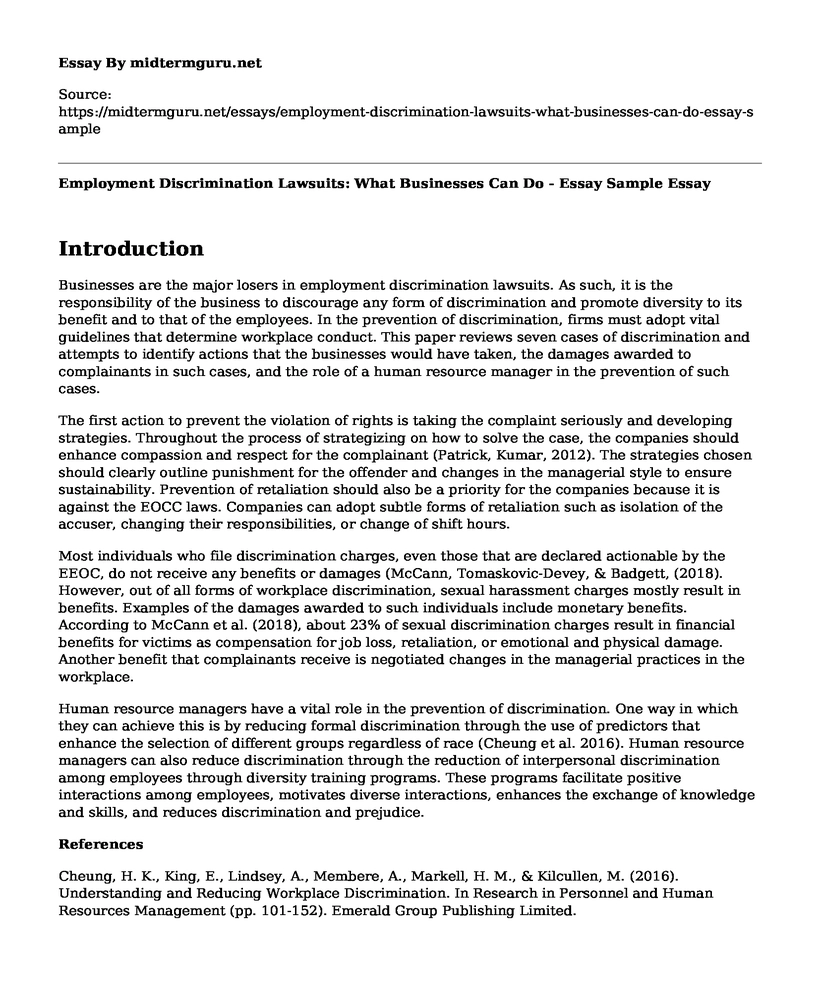Introduction
Businesses are the major losers in employment discrimination lawsuits. As such, it is the responsibility of the business to discourage any form of discrimination and promote diversity to its benefit and to that of the employees. In the prevention of discrimination, firms must adopt vital guidelines that determine workplace conduct. This paper reviews seven cases of discrimination and attempts to identify actions that the businesses would have taken, the damages awarded to complainants in such cases, and the role of a human resource manager in the prevention of such cases.
The first action to prevent the violation of rights is taking the complaint seriously and developing strategies. Throughout the process of strategizing on how to solve the case, the companies should enhance compassion and respect for the complainant (Patrick, Kumar, 2012). The strategies chosen should clearly outline punishment for the offender and changes in the managerial style to ensure sustainability. Prevention of retaliation should also be a priority for the companies because it is against the EOCC laws. Companies can adopt subtle forms of retaliation such as isolation of the accuser, changing their responsibilities, or change of shift hours.
Most individuals who file discrimination charges, even those that are declared actionable by the EEOC, do not receive any benefits or damages (McCann, Tomaskovic-Devey, & Badgett, (2018). However, out of all forms of workplace discrimination, sexual harassment charges mostly result in benefits. Examples of the damages awarded to such individuals include monetary benefits. According to McCann et al. (2018), about 23% of sexual discrimination charges result in financial benefits for victims as compensation for job loss, retaliation, or emotional and physical damage. Another benefit that complainants receive is negotiated changes in the managerial practices in the workplace.
Human resource managers have a vital role in the prevention of discrimination. One way in which they can achieve this is by reducing formal discrimination through the use of predictors that enhance the selection of different groups regardless of race (Cheung et al. 2016). Human resource managers can also reduce discrimination through the reduction of interpersonal discrimination among employees through diversity training programs. These programs facilitate positive interactions among employees, motivates diverse interactions, enhances the exchange of knowledge and skills, and reduces discrimination and prejudice.
References
Cheung, H. K., King, E., Lindsey, A., Membere, A., Markell, H. M., & Kilcullen, M. (2016). Understanding and Reducing Workplace Discrimination. In Research in Personnel and Human Resources Management (pp. 101-152). Emerald Group Publishing Limited.
McCann, C., Tomaskovic-Devey, D., & Badgett, L. (2018). Employers' Response to Sexual Harassment. Available at SSRN 3407960.
Patrick, H. A., Kumar, V. R. (2012). Managing Workplace Diversity: Issues and Challenges. Retrieved from https://doi.org/10.1177/2158244012444615
Cite this page
Employment Discrimination Lawsuits: What Businesses Can Do - Essay Sample. (2023, Jan 16). Retrieved from https://midtermguru.com/essays/employment-discrimination-lawsuits-what-businesses-can-do-essay-sample
If you are the original author of this essay and no longer wish to have it published on the midtermguru.com website, please click below to request its removal:
- Paper Example on Group Conflict in the Human Services Field
- Analysis of Suicide Policy - Paper Example
- Paper Example on Bus Travelling
- Paper Example on Triumph Motorcycle Ltd International Expansion Plan After Brexit
- Essay Sample on Physical Intervention Program Among Sedentary Workers
- Research Paper on Endless Human Trafficking
- Toyota's Environmental Pollution: Ethical Actions & Behaviour - Research Paper







